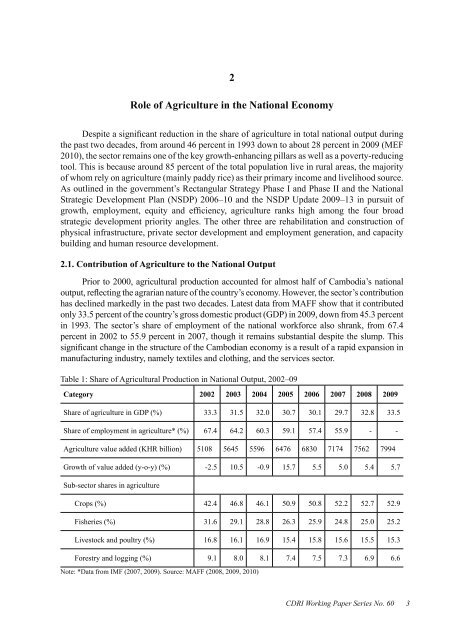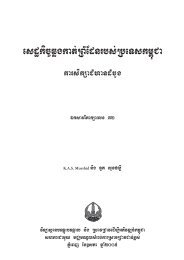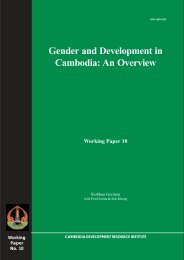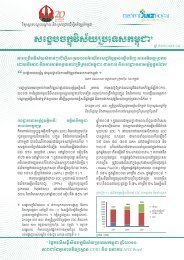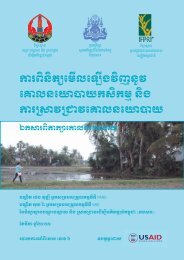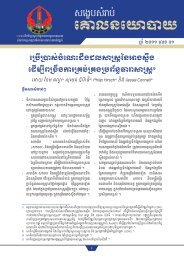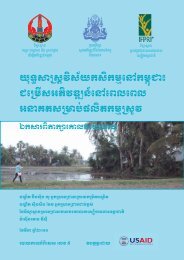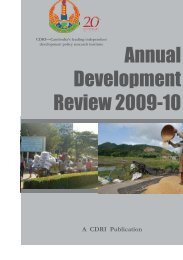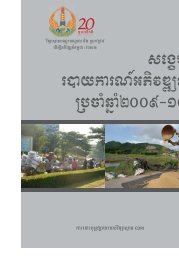Foreign Investment in Agriculture in Cambodia CDRI Working Paper ...
Foreign Investment in Agriculture in Cambodia CDRI Working Paper ...
Foreign Investment in Agriculture in Cambodia CDRI Working Paper ...
Create successful ePaper yourself
Turn your PDF publications into a flip-book with our unique Google optimized e-Paper software.
2<br />
Role of <strong>Agriculture</strong> <strong>in</strong> the National Economy<br />
Despite a significant reduction <strong>in</strong> the share of agriculture <strong>in</strong> total national output dur<strong>in</strong>g<br />
the past two decades, from around 46 percent <strong>in</strong> 1993 down to about 28 percent <strong>in</strong> 2009 (MEF<br />
2010), the sector rema<strong>in</strong>s one of the key growth-enhanc<strong>in</strong>g pillars as well as a poverty-reduc<strong>in</strong>g<br />
tool. This is because around 85 percent of the total population live <strong>in</strong> rural areas, the majority<br />
of whom rely on agriculture (ma<strong>in</strong>ly paddy rice) as their primary <strong>in</strong>come and livelihood source.<br />
As outl<strong>in</strong>ed <strong>in</strong> the government’s Rectangular Strategy Phase I and Phase II and the National<br />
Strategic Development Plan (NSDP) 2006–10 and the NSDP Update 2009–13 <strong>in</strong> pursuit of<br />
growth, employment, equity and efficiency, agriculture ranks high among the four broad<br />
strategic development priority angles. The other three are rehabilitation and construction of<br />
physical <strong>in</strong>frastructure, private sector development and employment generation, and capacity<br />
build<strong>in</strong>g and human resource development.<br />
2.1. Contribution of <strong>Agriculture</strong> to the National Output<br />
Prior to 2000, agricultural production accounted for almost half of <strong>Cambodia</strong>’s national<br />
output, reflect<strong>in</strong>g the agrarian nature of the country’s economy. However, the sector’s contribution<br />
has decl<strong>in</strong>ed markedly <strong>in</strong> the past two decades. Latest data from MAFF show that it contributed<br />
only 33.5 percent of the country’s gross domestic product (GDP) <strong>in</strong> 2009, down from 45.3 percent<br />
<strong>in</strong> 1993. The sector’s share of employment of the national workforce also shrank, from 67.4<br />
percent <strong>in</strong> 2002 to 55.9 percent <strong>in</strong> 2007, though it rema<strong>in</strong>s substantial despite the slump. This<br />
significant change <strong>in</strong> the structure of the <strong>Cambodia</strong>n economy is a result of a rapid expansion <strong>in</strong><br />
manufactur<strong>in</strong>g <strong>in</strong>dustry, namely textiles and cloth<strong>in</strong>g, and the services sector.<br />
Table 1: Share of Agricultural Production <strong>in</strong> National Output, 2002–09<br />
Category 2002 2003 2004 2005 2006 2007 2008 2009<br />
Share of agriculture <strong>in</strong> GDP (%) 33.3 31.5 32.0 30.7 30.1 29.7 32.8 33.5<br />
Share of employment <strong>in</strong> agriculture* (%) 67.4 64.2 60.3 59.1 57.4 55.9 - -<br />
<strong>Agriculture</strong> value added (KHR billion) 5108 5645 5596 6476 6830 7174 7562 7994<br />
Growth of value added (y-o-y) (%) -2.5 10.5 -0.9 15.7 5.5 5.0 5.4 5.7<br />
Sub-sector shares <strong>in</strong> agriculture<br />
Crops (%) 42.4 46.8 46.1 50.9 50.8 52.2 52.7 52.9<br />
Fisheries (%) 31.6 29.1 28.8 26.3 25.9 24.8 25.0 25.2<br />
Livestock and poultry (%) 16.8 16.1 16.9 15.4 15.8 15.6 15.5 15.3<br />
Forestry and logg<strong>in</strong>g (%) 9.1 8.0 8.1 7.4 7.5 7.3 6.9 6.6<br />
Note: *Data from IMF (2007, 2009). Source: MAFF (2008, 2009, 2010)<br />
<strong>CDRI</strong> Work<strong>in</strong>g <strong>Paper</strong> Series No. 60<br />
3


